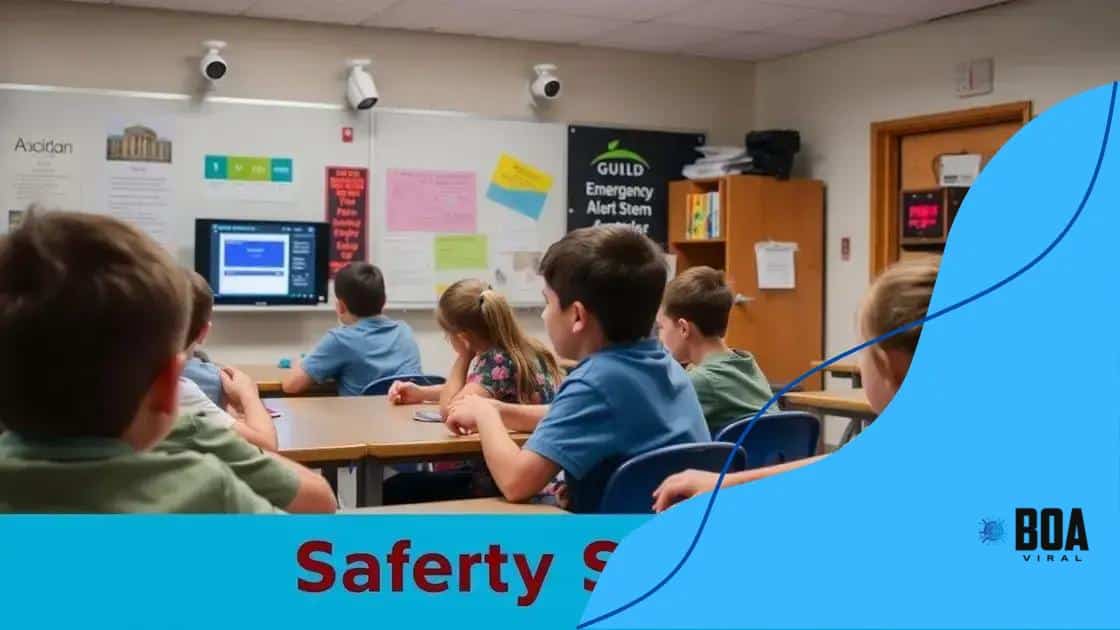School safety technology funding plans for better protection

School safety technology funding plans focus on integrating advanced tools and practices to enhance security, utilizing diverse funding sources while staying ahead of future trends in technology and community engagement.
School safety technology funding plans play a crucial role in creating secure environments for students. Have you ever wondered how schools ensure safety through technology? Let’s dive into the details.
Understanding school safety technology
Understanding school safety technology is vital for creating a secure learning environment. With advancements in technology, schools can implement various solutions that protect students and staff. Let’s explore some of the essential tools that are making a difference.
Key Technologies Used in Schools
There are several key technologies that are widely used to enhance safety in educational settings. These include:
- Surveillance cameras that monitor school premises.
- Access control systems that limit entry points.
- Emergency alert systems for quick notifications.
- Visitor management tools that track who is in the building.
By using surveillance cameras, schools can ensure constant monitoring of their grounds. This deters potential threats and provides instant evidence if an incident occurs. Furthermore, access control systems allow only authorized personnel into sensitive areas, ensuring a safer environment for students.
Importance of Training and Awareness
Alongside technology, training is crucial for effectively utilizing these tools. Staff must be educated on how to respond in emergencies and use safety technologies properly. Regular drills and workshops can enhance preparedness, ensuring everyone knows their role during a crisis.
In addition to training, creating awareness among students about safety protocols is essential. Educating them on the use of emergency systems helps them react calmly and appropriately. When students are aware, they contribute to the overall safety of their school environment, fostering a community-focused on protection.
Investments in school safety technology can lead to increased student confidence and well-being. A safe school allows students to focus on their education without fear, making it imperative that schools prioritize these initiatives.
Key funding sources available
Understanding the key funding sources available for school safety initiatives is essential for enhancing security. Many programs and resources can help schools implement necessary technologies and practices.
Federal Funding Opportunities
The federal government provides various funding options focused on improving school safety. Some prominent sources include:
- The School Safety National Activities Program, which offers grants for safety technologies.
- The COPS School Violence Prevention Program, funding law enforcement and safety measures in schools.
- The 21st Century Community Learning Centers program, which can also be utilized for safety-related activities.
By tapping into these federal programs, schools can access vital funds that support safety measures and technology upgrades. Local educational agencies should actively search for grant opportunities that align with their needs.
State and Local Grants
Many states offer their own funding sources for school safety initiatives as well. Depending on the state, these grants may support technology integration, training programs, and infrastructure improvements. Each state has its own application process, so it’s important for schools to stay informed about local opportunities.
Additionally, local governments may have specific funds allocated for safety in education. Schools should collaborate with local officials to explore these options. Achieving school safety requires a comprehensive approach, and utilizing all available funding sources is critical.
Another valuable resource is private sector funding. Numerous organizations and companies prioritize community support. They may provide grants or donations aimed at enhancing school safety. Schools should consider forming partnerships with local businesses to secure these resources.
In conclusion, exploring various funding sources is crucial for schools aiming to improve their safety measures. By identifying and applying for federal, state, local, and private funding opportunities, schools can secure the necessary resources to implement effective safety solutions.
Impact of technology on student security

The impact of technology on student security is significant and positive. As schools integrate advanced tools, they create safer environments for learning. From surveillance systems to emergency alert systems, technology helps ensure the safety of students and staff.
Enhanced Monitoring and Response
One major effect of technology is improved monitoring. Surveillance cameras placed in key areas facilitate real-time observation of school grounds. This capability not only deters misconduct but also enables quick responses during emergencies.
- Quick identification of potential threats.
- Real-time alerts to law enforcement when needed.
- Detailed records of incidents for review.
Another vital aspect is the use of emergency alert systems. These systems can instantly notify staff and students of any danger, allowing them to take appropriate actions swiftly. For example, during a lockdown, alerts can be sent via text messages or alarms, providing essential information without delay.
Improving Communication
With the advancement of communication technologies, students and staff can share information more effectively. Tools such as mobile apps or dedicated platforms allow quick reporting of suspicious activities. This encourages a culture of safety and vigilance.
Additionally, technology enhances training through simulations and drills. Schools can use virtual reality to conduct realistic emergency scenarios. This not only prepares everyone for actual events but also builds confidence in the procedures.
As technology continues to evolve, its role in enhancing student security expands. Schools must keep pace with these advancements to stay safe and protected. With the right integration of tools, they can create an environment where students feel secure and focused on learning.
Best practices in funding allocation
Best practices in funding allocation for school safety are crucial for maximizing resources. Schools need to ensure that every dollar spent enhances safety and security effectively. Careful planning and strategic allocation can lead to successful outcomes.
Assessing Needs and Setting Priorities
The first step in effective funding allocation is assessing the specific safety needs of the school. This may include evaluating existing security measures, conducting surveys, and identifying areas for improvement. Schools should prioritize funding based on the highest risks and urgent needs.
- Identify specific security gaps that need addressing.
- Engage with teachers, parents, and students for input.
- Analyze data on incidents to inform decisions.
Once schools understand their highest priorities, they can allocate funds to address those specific areas. This targeted approach ensures that funding goes where it is most needed, maximizing its impact.
Diversifying Funding Sources
Relying on a single source of funding can be risky. Schools should explore multiple avenues such as grants, local government support, and community donations. Having a diverse funding portfolio provides stability and increases the chances of securing necessary resources.
Collaboration with local businesses and organizations can also result in sponsorship opportunities. These partnerships can provide additional financial support while creating a sense of community involvement in school safety efforts.
Another essential practice is creating a transparent budgeting process. Schools must communicate how funds are allocated and their impacts on safety. This transparency builds trust within the community and encourages ongoing support for future funding initiatives.
By implementing these best practices in funding allocation, schools can enhance safety measures while ensuring that community resources are used efficiently. Taking a proactive approach fosters a secure environment for all students and staff.
Future trends in school safety
Future trends in school safety highlight the ongoing evolution of security measures within educational environments. As technology advances, schools are adopting innovative solutions that address emerging challenges. Understanding these trends is essential for maintaining secure learning spaces.
Integration of Artificial Intelligence
One significant trend is the integration of artificial intelligence (AI) in safety systems. AI can analyze data from surveillance cameras in real-time. This helps identify potential threats quickly and assists in decision-making during emergencies. Schools will increasingly rely on AI to enhance their security protocols.
- Predictive analytics to foresee potential problems.
- Facial recognition for authorized access control.
- Automated alerts based on abnormal behavior.
This integration not only helps in preventing incidents but also provides valuable insights into patterns of behavior that can improve safety measures.
Enhanced Communication Tools
Another trend includes the development of enhanced communication tools. Schools are adopting platforms that allow for faster reporting and response. For example, mobile apps enable students to report suspicious activities anonymously.
These tools also facilitate better communication between parents and school officials during emergencies. Quick access to information ensures everyone is informed, promoting a collective effort towards safety.
Moreover, virtual reality (VR) training for staff and students is set to become more common. VR can simulate emergency scenarios like lockdowns or evacuations, providing realistic practice that builds confidence in handling real situations.
As schools embrace these future trends, the focus will shift toward creating holistic safety environments. By understanding and implementing these advancements, educational institutions can foster spaces where students feel secure and supported in their learning journey.
In summary, enhancing school safety through technology and funding is more important than ever. By adopting innovative tools and practices, schools can create secure environments for students and staff. Understanding key funding sources and best practices in allocation allows for effective resource management. Future trends will continue to shape how safety is approached in education, integrating advanced technologies and encouraging community involvement. Together, these efforts ensure that students can focus on learning while feeling safe and protected.
FAQ – Frequently Asked Questions about School Safety Technology Funding Plans
What are the primary funding sources for school safety?
Primary funding sources include federal grants, state resources, and private donations. Schools should explore all available options to enhance safety.
How does technology improve school safety?
Technology improves school safety by providing real-time monitoring, emergency alerts, and effective communication tools, creating a safer environment for students.
What are best practices in funding allocation for school safety?
Best practices include assessing specific needs, diversifying funding sources, and maintaining transparency in budget allocations to ensure effective resource use.
What future trends are expected in school safety?
Future trends include increased use of artificial intelligence, improved communication tools, and virtual reality training for staff and students.






